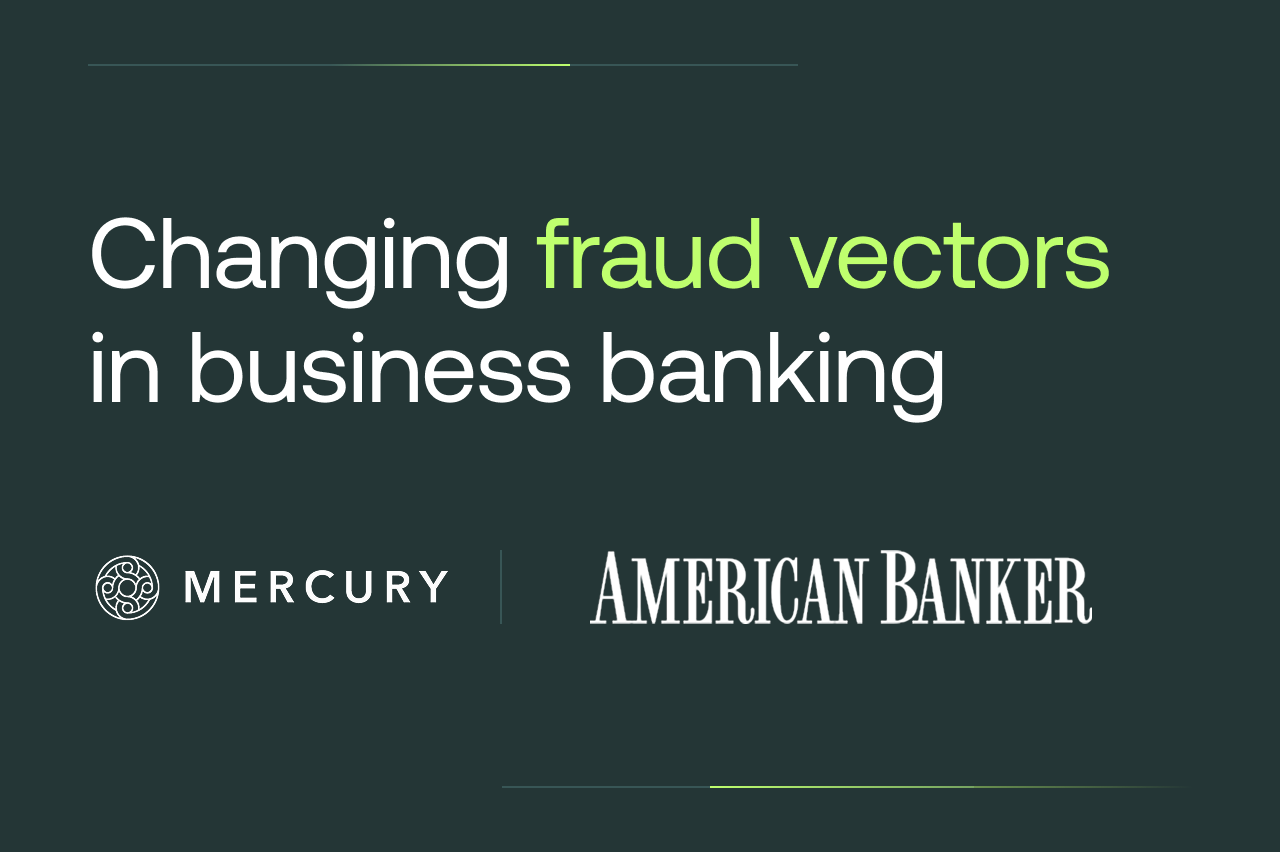Fraud vectors are shifting fast, and traditional defenses can’t keep up. But Mercury isn’t standing still.
In a recent American Banker webinar, Sumeet Abichandani, BSA/AML and Sanctions Officer at Mercury, joined Middesk CEO Kyle Mack to unpack how financial institutions can rethink business onboarding and monitoring in response to today’s biggest fraud threats.
Here’s how Mercury is approaching business identity in 2025 — and what the rest of the industry can take away from it.
Mercury collects more up front and gets better outcomes later
While most institutions are still aiming for one-click onboarding, Mercury takes the opposite path — ask for more information up front, then use that data to automate what matters. “We actually ask our customers for a lot of information upfront,” Sumeet said. “And then we bump all of that data up against data aggregators like Middesk to make sure that what the customer’s providing is complete and accurate.”
It’s a deliberate tradeoff: a more comprehensive onboarding experience that prevents unnecessary back-and-forth later. “Our customers don’t mind going through the process of filling out a bank application,” he added. “They’d rather do it once, and not have to think about it again.” That approach lets Mercury verify business legitimacy and get early fraud signals without compromising on experience.
Hear Sumeet Abichandani discuss why Mercury asks for more upfront during onboarding—and how that leads to better fraud outcomes later.
Good signals reduce friction, especially for good customers
As fraud tactics get more sophisticated, Mercury is using a combination of external data, internal monitoring, and team-driven typology development to flag high-risk activity. “We’ve launched a fraud-at-onboarding program,” Sumeet explained, “where we’re actually looking for fraud signals very diligently at onboarding so we can block bad companies before they even get in the door.”
This layered strategy helps Mercury preserve a smooth experience for the legitimate businesses they’re designed to serve. “It’s a little bit like asking somebody to tell you their life story so you can get comfortable with them and build trust out the gate,” Sumeet said. “It’s no longer just: do they have a name, address, SSN. It’s understanding their history, where they banked previously, what kind of activity they’ll be doing — and monitoring that to make sure we have the right signal at any given time.”
Kyle echoed the importance of data in reducing manual reviews, especially for low-risk applicants. “We want people to trust the story we tell about companies,” he said. “The more data you can pull together to build that story, the more confident your team can be in making real-time, automated decisions.”
Listen to Kyle share how building a complete story around each business helps reduce manual reviews and drive confident, automated decisions.
Monitoring is the hard part — and the most important
Most institutions focus their efforts on onboarding, but risk doesn’t stop at the front gate. “What happens when the customer actually gets on the platform is much more important,” Sumeet said. “You have to refresh your knowledge of that customer through things like secretary of state filings. Is the business going dormant? Why? Did they forget to file, or is something else going on?”
He also described how Mercury protects customers during those dormant periods: “If a business pauses, we lock access to the account to protect them from account takeover. When they’re ready to come back, it’s just a self-check. No need to start over.”
Kyle noted that most institutions still struggle to make monitoring useful. “There’s a lot of noise,” he said. “Most filings aren’t risky. So you have to ask: what does it look like for a company to move between risk levels in aggregate, not just trigger alerts for every single change.”
Learn how Mercury monitors risk after onboarding, as Sumeet Abichandani explains their approach to detecting red flags during periods of dormancy.
Automation will grow, but only with control
AI is playing a growing role in onboarding and fraud prevention, but both speakers cautioned against over-automation. “There’s very little appetite for error in KYB and KYC,” Sumeet said. “We’re building a model risk management team to pilot these tools responsibly. AI can help with things like gathering open-source intelligence—but we’re not at a point where we can delegate decision-making.”
Kyle agreed that agentic workflows today are mostly copilots. “Most of the tooling is about accelerating manual reviews,” he said. “It’s still common to see institutions making automated decisions on just 5–15% of incoming applications. Everything else goes to doc requests and manual queues.”
The opportunity lies in using AI to look at more data, faster—then distill it into something useful for human decision-makers. “We had a case recently where a website looked totally credible,” Kyle recalled. “But in the metadata, there were links to offshore gambling sites. A person reviewing the site would’ve missed that. But tools that can scan the code help us catch what’s hiding in plain sight.”
Kyle Mack explains where AI fits into business identity today, and why tools that surface hidden signals are more valuable than full automation.
What the industry should be asking next
Mercury’s business identity strategy is a reminder that the biggest differentiators in 2025 aren’t flashy AI features or sleek onboarding flows — they’re thoughtful systems designed to scale trust. From verifying small businesses that don’t look like traditional customers to spotting unusual behavior buried deep in a website’s metadata, it’s clear that success in this space depends on nuance, not just speed.
As both Kyle and Sumeet emphasized, there’s no silver bullet. It’s about combining the right data, tools, and internal judgment to make better decisions — and constantly evolving your playbook as fraud tactics shift and business models change.
The question for every institution now isn’t just how you’re verifying businesses — it’s how quickly your business identity program can adapt. Because in a world of 5 million new businesses a year, adaptability isn’t a nice-to-have. It’s survival.




